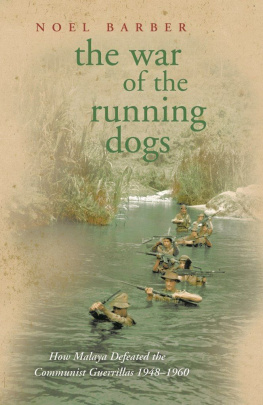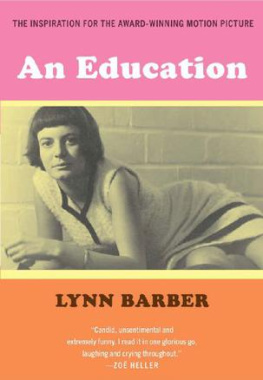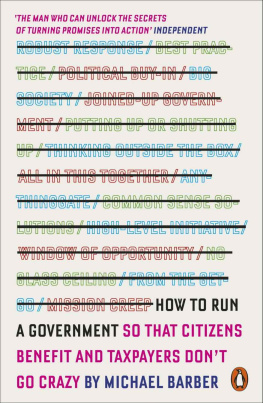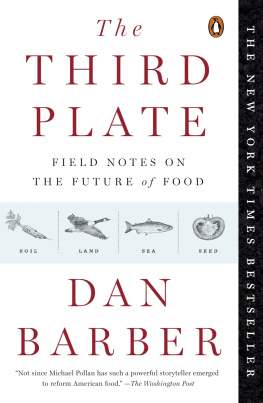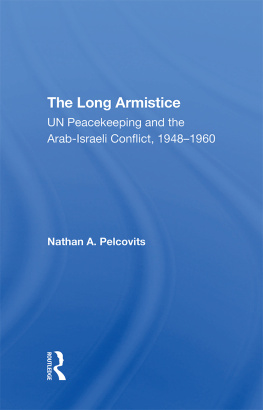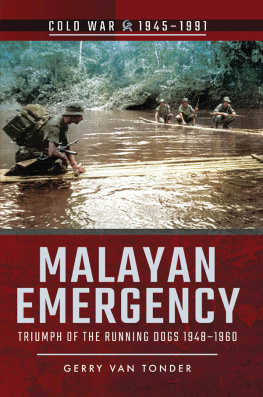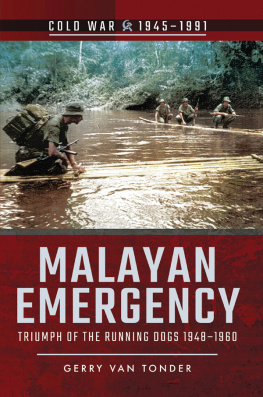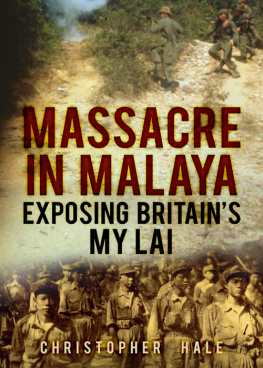Barber - The War of the Running Dogs: Malaya 1948-1960
Here you can read online Barber - The War of the Running Dogs: Malaya 1948-1960 full text of the book (entire story) in english for free. Download pdf and epub, get meaning, cover and reviews about this ebook. year: 2013, publisher: Orion, genre: Detective and thriller. Description of the work, (preface) as well as reviews are available. Best literature library LitArk.com created for fans of good reading and offers a wide selection of genres:
Romance novel
Science fiction
Adventure
Detective
Science
History
Home and family
Prose
Art
Politics
Computer
Non-fiction
Religion
Business
Children
Humor
Choose a favorite category and find really read worthwhile books. Enjoy immersion in the world of imagination, feel the emotions of the characters or learn something new for yourself, make an fascinating discovery.
- Book:The War of the Running Dogs: Malaya 1948-1960
- Author:
- Publisher:Orion
- Genre:
- Year:2013
- Rating:3 / 5
- Favourites:Add to favourites
- Your mark:
- 60
- 1
- 2
- 3
- 4
- 5
The War of the Running Dogs: Malaya 1948-1960: summary, description and annotation
We offer to read an annotation, description, summary or preface (depends on what the author of the book "The War of the Running Dogs: Malaya 1948-1960" wrote himself). If you haven't found the necessary information about the book — write in the comments, we will try to find it.
The War of the Running Dogs: Malaya 1948-1960 — read online for free the complete book (whole text) full work
Below is the text of the book, divided by pages. System saving the place of the last page read, allows you to conveniently read the book "The War of the Running Dogs: Malaya 1948-1960" online for free, without having to search again every time where you left off. Put a bookmark, and you can go to the page where you finished reading at any time.
Font size:
Interval:
Bookmark:
RUNNING DOGS
Communist Guerillas 194860
The Revolution was effected before the war commenced. The Revolution was in the minds and hearts of the people
John Adams, USA, 1818
The answer lies not in pouring more troops into the jungle, but in the hearts and minds of the people
General Templer, Malaya, 1952
CASSELL
FOR SIMONETTA WITH LOVE
The Government
SIR EDWARD GENT High Commissioner
SIR HENRY GURNEY High Commissioner
GEN. SIR HAROLD BRIGGS First Director of Operations
GEN. SIR GERALD TEMPLER First Supremo
SIR ROBERT THOMPSON Malayan Civil Service, later Secretary for Defence
MALCOLM MACDONALD Commissioner-General for South-East Asia
The Police
NICOL GRAY Commissioner, 194852
COL. ARTHUR YOUNG his successor
IRENE LEE
DAVID STORRIER Special Branch
EVAN DAVIES
TWO - GUN BILL STAFFORD Officer in charge of Detectives, Kuala Lumpur
The Malayans
TUNKU ABDUL RAHMAN Malayas first Prime Minister
YEOP MAHIDIN leader of 26,000 kampong guards
C. C. TOO Psychological Warfare Expert
Planters and Miners
PETER LUCY rubber planter
ROBERT PUCKERIDGE rubber planter
IRA PHELPS tin miner
NORMAN CLEAVELAND tin miner
The Communists
CHIN PENG leader of the Malayan Communist Party
LAU YEW head of the armed forces
LAM SWEE Political Commissar
LEE MENG leading girl courier
SHORTY KUK leader of Johore Communists
OSMAN CHINA key propaganda expert
GOH PENG TUN
HOR LUNG
ABDULLAH CD leading Malay Communist
CTs
Throughout this book Communist guerrilla fighters are referred to as CTs, short for Communist Terrorists. At first they were officially labelled bandits until the British discovered that this word had unfortunate connotations. Bandits had been the identical term used by the Japanese and Chiang Kai-shek to describe Communists; since neither of these powers had been successful, the use of bandits by the British put them on a similar level in the eyes of Malayan Chinese. The British therefore changed bandit to Communist Terrorist or CT. In order to make for easier reading, I have used the term throughout.
A War or an Emergency?
It was a war but there was a curious reason why it was never called one. As the author John Gullick, an authority on Malaya and one-time member of the Malayan Civil Service, points out, It was a war though out of regard for the London insurance market, on which the Malayan economy relied for cover, no one ever used the word. This misnomer continued for twelve years, for the simple reason that insurance rates covered losses of stocks and equipment through riot and civil commotion in an emergency, but not in a civil war.
Straits Dollars
During the war there were eight Straits dollars to the sterling, and all computations have been made at this rate.
So many people have helped me with the research for this book, that it would be invidious to single out a few names, ranging as they do from high-ranking generals and politicians to Malay policemen and ex-Communists. There is also another more intriguing reason why it would be unfair to name only these people: a great deal of my information came from Special Branch leaders who could not in any case by identified. This is, after all, the story of a war planned and won largely by civilian and police effort with the military in a supporting role, and many of the anonymous Special Branch chiefs responsible for victory are still on active service. To them and all the others who so generously gave me their time, advice and documents, I offer my most sincere thanks.
I would also like to thank Donald Dinsley, my research collaborator in many books, for his valuable help in many parts of the world while I was working and writing in Malaysia.
My grateful thanks are also due to those authors and publishers who kindly gave me permission to publish extracts from their books.
N.B. Kuala Lumpur, 196970
Above all else, and from the earliest moments of history, one primordial force has dominated the life of every man, woman and child in Malaya the gentle Malays themselves, the industrious Chinese, the listless Indians, the perspiring British alike. It is the jungle; the jungle which none can escape, the jungle which reaches to the back of every compound, to the back of every mind; the jungle which blots out the sun over four-fifths of Malayas 50,850 square miles. Harsh and elemental, implacable to all who dare to trifle with its suffocating heat or hissing rains, the jungle alone has remained untamed and unchanged.
Here the tall trees with their barks of a dozen hues, ranging from marble white to scaly greens and reds, thrust their way up to a hundred feet or even double that height, straight as symmetrical cathedral pillars, until they find the sun and burst into a green carpet far, far above; trees covered with tortuous vines and creepers, some hanging like the crazy rigging of a wrecked schooner, some born in the fork of a tree, branching out in great tufts of fat green leaves or flowers; others twisting and curling round the massive trunks, throwing out arms like clothes-lines from tree to tree. In places the jungle stretches for miles at sea level and then it often degenerates into marsh, into thick mangrove swamp that can suck a man out of sight in a matter of minutes. In the heart of the country the giant trees cover the great north-south mountain range that rises to 7,000 feet, virtually bisecting Malaya from north to south.
In an evergreen world of its own that will never know the stripped black branches of winter, elephants, tigers, bears and deer roam the thick undergrowth; flying foxes, monkeys and parrots chatter and screech in its high places; crocodiles lie motionless in the swamp; a hundred and thirty varieties of snake slither across the dead leaves on wet ground; the air is alive with the hum of mosquitoes ferocious enough to bite through most clothing; and on the saplings and ferns struggling to burst out of the undergrowth thousands of fat, black, bloodsucking leeches wait patiently for human beings to brush against them. Only on the jungle fringe is there colour and light and a beauty unmarred by fear. Here, when the sun comes out after a tropical shower, thousands of butterflies hang across the heat-hazed paths in iridescent curtains. Brightly coloured tropical birds dart like jewels between clumps of bamboo, giant ferns, ground orchids, flame of the forest trees, bougainvillaea, wild hibiscus, in a countryside heavy with the scent of waxen-like frangipani blossoms, where the occasional monkey watches suspiciously from the heights of a tulip tree with its clusters of poppy-red flowers.
This is the jungle and this was, for twelve years, to be the battlefield for a strange and terrible war, as relentless and as cruel as the jungle itself; one in which Communism for the first time in history launched an all-out guerrilla war with the avowed aim of conquering Malaya for the disciples of Mao Tse-tung.
Malaya is one of the most beautiful countries on earth. Pear-shaped, hanging like a five-hundred-mile-long pendant below the narrow Kra isthmus which links it to Thailand its only land frontier it is a little larger than England without Wales, a little smaller than the State of Florida. To the south lies Singapore and, below the equator, the scattered spice islands of Indonesia; to the west the still, hot waters of the Indian Ocean stretch to Africa; to the east the China Sea swirls westwards to the Philippines and the Pacific, northwards until its breakers dash against the shores of countries whose very names are evocative of blood spilled in racial wars Cambodia, Vietnam, Hong Kong, China, Japan, Korea.
Font size:
Interval:
Bookmark:
Similar books «The War of the Running Dogs: Malaya 1948-1960»
Look at similar books to The War of the Running Dogs: Malaya 1948-1960. We have selected literature similar in name and meaning in the hope of providing readers with more options to find new, interesting, not yet read works.
Discussion, reviews of the book The War of the Running Dogs: Malaya 1948-1960 and just readers' own opinions. Leave your comments, write what you think about the work, its meaning or the main characters. Specify what exactly you liked and what you didn't like, and why you think so.

